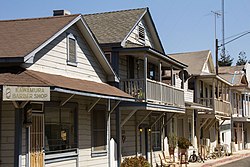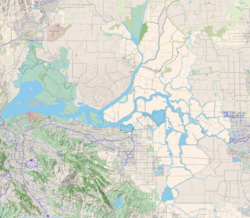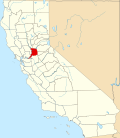1800s
Established in 1851 by John W. Sharp, Walnut Grove is one of the earliest Chinese American settlements along the Sacramento River. Many of the original settlers were forced to Walnut Grove, after their previous homes and towns were burnt down. The city was rented to the Chinese by John Wesley Sharp.
After Sharp’s death in 1880, his heirs sold Walnut Grove to Alex Brown and his mother Agnes. Brown was a highly successful entrepreneur and a staunch supporter of the Chinese and Japanese communities in Walnut Grove. He provided financial backing to several Asian businessmen and rented land to others at reasonable rates. [26] The Brown family subsequently became heavily involved in the commercial life of the community, operating a general store, hotel, and asparagus packing house, as well as the Bank of Alex Brown. [27]
Exhausted from their previous experiences with arson, the Chinese built simple, large, and inexpensive buildings. Estimated to have cost about $800 USD each at the time.
The community was made up of residents from two different areas of Guangdong Province in southern China - Heungshan County (modern day Zhongshan) on the east side of the Pearl River and Sze Yup made up of four districts - Xinhui, Taishan, Kaiping and Enping – on the west side of the Pearl River. Besides being from different areas in China the residents also spoke different dialects and could not communicate easily with one another. Walnut Grove’s Chinese community was primarily from Heungshan and outnumbered those from Sze Yup by almost ten to one. As was common in Chinese immigrant communities in the U.S., the community in Walnut Grove organized tongs (voluntary associations) formed around shared interests such as a home district in China, family names, and native dialects. The various tongs provided support and protection to newly arriving Chinese immigrants and were in constant competition for influence within Walnut Grove’s Chinatown.
During the 1880 and 1890s, Chinese businessmen in Walnut Grove developed a thriving commercial and social center for the hundreds of Chinese, Japanese, and Filipino agricultural laborers who worked throughout the Delta region. Businesses operating in Chinatown included dry goods and grocery stores, restaurants, laundries, shoe stores, fish and meat markets, saloons, gambling halls, boarding houses, herbal shops, temples, and baths. Of particular importance to the Chinese communities throughout the region was Walnut Grove's Bing Kong Tong Society, a branch of the San Francisco Bing Kong Tong Society. The Society established the branch in Walnut Grove before World War I to manage labor relationships, regulate gambling, provide mail and bank services, and help laborers find work. It also sent the bones of the deceased back to China for burial and helped Chinese immigrants return to their native land. At its height, the Bing Kong Tong Society branch in Walnut Grove was the most important social organization in the region’s Chinese community with over 400 active members from throughout the Delta. [26]
1900s
Early Japanese immigrants described travel through the Sacramento Delta area as going "down river," leading the Issei to call the area around Walnut Grove, "Kawashimo." Chinese immigrants had harnessed the delta’s fertility in the 1870-80s by creating a network of levees and inland islands that controlled flooding in what had been a marshy swamp. White landowners reaped the primary benefits from this major project of land "reclamation" and dominated the local economy, along with the multiethnic population of immigrants who arrived in succession from China, Japan, East India, the Philippines and Mexico to work the fields around Walnut Grove.
Unlike other Japanese agricultural settlements, where some immigrants were able to purchase land and establish independent farms, Kawashimo remained wholly owned by a few white landholders. Issei farmers arrived in Walnut Grove after 1892 and established themselves in fruit, tomatoes, beans and asparagus production, first as itinerant contract laborers and then through tenant farming. Walnut Grove emerged as a hub for Japanese in the delta area and by the 1930s, over 100 Nikkei families farmed around Walnut Grove. Kawashimo’s Japantown had a bustling commercial area to serve their recreational and material needs, as well as community institutions such as the Buddhist and Methodist Churches, a Japanese language school, Kenjinkai (prefectural associations) and Japanese Association.
In 1915, a catastrophic fire consumed Walnut Grove's Chinatown and a portion of the smaller Japantown. Tensions between these communities led the Japanese immigrants to rebuild on adjacent blocks owned by Alex Brown, a farmer, banker and major landholder who helped amend the Alien Land Laws to maintain his profitable relationship with Japanese immigrants. Brown installed water and sewage lines and constructed seven commercial buildings offered for rent, along with additional parcels on which he encouraged Nikkei to build. Families drew numbers out of a hat to determine on which lot they would build their homes and businesses. Japanese builders and carpenters came from as far as San Francisco to lend their expertise and labor to the task of rebuilding Kawashimo's Japantown. The neighborhood still features the narrow streets lined by two-story wooden structures with overhanging balconies that the Issei created in 1915. Even the underlying property arrangements, in which Nikkei owned the house but not the underlying land, were not changed until the late 1990s.
As a rare example of a Japanese enclave designed and built by immigrants themselves, the commercial core of Walnut Grove's Japantown was designated a National Register historic district in 1990 (as was the neighboring Chinatown). The Preserving California's Japantowns volunteer survey team of Barbara Takei, Janet Sakata and Louie Watanabe made an important contribution to the existing National Register information by documenting the "backtown" area of Walnut Grove's Japantown. Just to the east across the Southern Pacific railroad tracks, "backtown's" larger blocks held many Nikkei residences, as well as a hotel, auto garages and the Buddhist Church and Japanese School building. [28]
In 1961, documentary photographer Pirkle Jones did a photo essay on Walnut Grove. [29]






